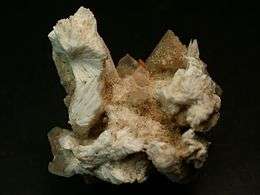Bassanite
Bassanite is a calcium sulfate mineral with formula CaSO4·1/2H2O or 2CaSO4·H2O. In other words it has half a water per CaSO4 unit hence its synonym calcium sulfate hemihydrate.
| Bassanite | |
|---|---|
 Bassanite (30 by 26 mm white mass with some gypsum crystals) | |
| General | |
| Category | Sulfate mineral |
| Formula (repeating unit) | CaSO4·1/2H2O |
| Strunz classification | 7.CD.45 |
| Crystal system | Monoclinic |
| Space group | Spheroidal (2) (same H-M symbol) |
| Unit cell | a = 12.0317 Å, b = 6.9269 Å, c = 12.6712 Å, β = 90.27°; Z = 12 |
| Identification | |
| Color | White |
| Crystal habit | Microscopic acicular crystals in parallel aggregates, pseudohexagonal |
| Twinning | Twin plane {101} |
| Luster | Earthy |
| Streak | White |
| Diaphaneity | Semitransparent |
| Specific gravity | 2.69–2.76 |
| Optical properties | Biaxial (+) |
| Refractive index | nα = 1.550–1.559, nβ = 1.560, nγ = 1.577–1.584 |
| 2V angle | 10–15° |
| Alters to | Dehydrates on heating to anhydrite |
| References | [1][2][3] |
Bassanite was first described in 1910 for an occurrence on Mount Vesuvius. It was named for Italian paleontologist Francesco Bassani (1853–1916).[1]
At Vesuvius it occurs as alterations from gypsum within leucite tephrite and as fumarole deposits. It occurs in dry lake beds in California and Australia. It also occurs interlayered with gypsum in caves.[2]
References
This article is issued from Wikipedia. The text is licensed under Creative Commons - Attribution - Sharealike. Additional terms may apply for the media files.